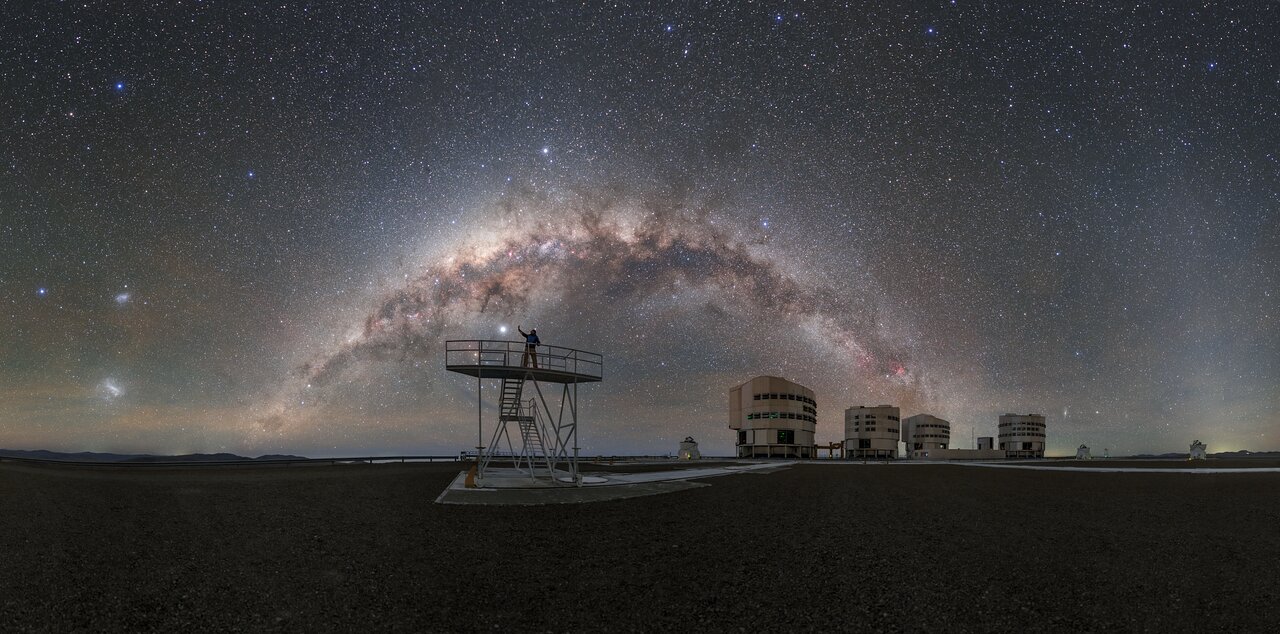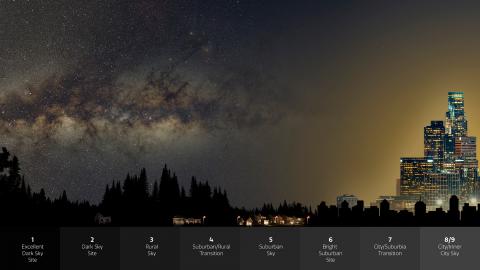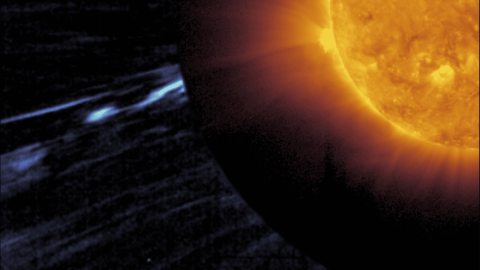European Southern Observatory denounces industrial megaproject threatening Chile's Paranal Observatory, the world's darkest observatory
In a press release, the European Southern Observatory (ESO) warns that a huge industrial complex threatens the skies above the Paranal Observatory in Chile's Atacama Desert. According to ESO, on 24 December, AES Andes, a subsidiary of the US electricity company AES Corporation, submitted for environmental impact assessment a project for a huge industrial complex that would be located between 5 and 11 kilometres from the Paranal telescopes. This astronomical observatory, the darkest in the world, has led to important breakthroughs, such as the first image of an exoplanet or the confirmation of the accelerated expansion of the universe.

ESO's Paranal Observatory is home to the Very Large Telescope (VLT). Standing on top of a platform at the VLT is photographer Petr Horálek, as if touching the gas giant Jupiter. Credit: ESO/P. Horálek.
David Galadí - ESO observatorio EN
David Galadí-Enríquez
Lecturer in the Department of Physics at the University of Cordoba
How does such an industrial complex affect light pollution?
‘All sources of artificial light at night generate light pollution and it is well known that industrial-type installations are particularly damaging because of the type of luminaires they incorporate, in theory for ‘safety’ reasons. An installation such as the one announced would undoubtedly have a major impact on its surroundings in terms of light pollution’.
How important is the Paranal Observatory for global astrophysical research?
‘The Cerro Paranal Observatory is currently the most important observatory in the world. Although there are a few larger telescopes, there is no other observatory that includes four eight-metre telescopes with the technological quality, state-of-the-art instrumentation and sky quality of Paranal. The neighbouring Cerro Armazones will soon host the European Extremely Large Telescope and will also be affected by this industrial installation.
Is this an isolated incident?
‘No. It is a serious case because of the size of the industrial installation and the truly unique quality of the observatory it will affect, but the natural darkness of the night is degrading at great speed all over the world, with all that this implies in terms of cultural, scientific and heritage loss, but also in terms of disruption of ecosystems and natural life’.
Alejandro Sánchez - ESO observatorio EN
Alejandro Sánchez de Miguel
EMERGIA post-doctoral research in the Sky Quality Office
The recently published study on light pollution in Chile, prepared by some of the world's leading experts in modelling, offers in principle the highest scientific guarantees. The data it presents confirms a growing concern: in Chile, light pollution has increased significantly in the last decade. We documented this in the study we organised at the Complutense University of Madrid and this trend continues to consolidate.
One of the main problems of Chilean legislation, at least in its best known version, is that it does not adequately consider the cumulative impact of different installations in an area, which introduces a risk factor for the preservation of dark skies. This is especially relevant in large-scale projects such as this one, which are located close to virtually pristine areas. These areas, so far, have minimal levels of light pollution, mainly limited to the skyline.
However, the construction of a mega-project as close as 5 to 10 kilometres away could have significant impacts. Not only would it increase direct light pollution through light emission, but it would also contribute to an increase of dust in the atmosphere, aggravating light scattering and affecting the quality of the night sky. This represents a considerable risk to the preservation of one of Chile's most valuable natural resources: its dark skies, which are a world reference for astronomy and science.
It is essential that any project of this nature rigorously considers both direct and cumulative impacts on the environment. Chile's dark skies are not only scientific, but also cultural and natural heritage, and their preservation should be an international priority.
The Cerro Paranal telescopes are the southern hemisphere's main window on the universe, and the new very large telescope, the ELT, is being built nearby on Cerro Armazones. To affect the quality of astronomical observation in these areas is to significantly damage the long-term ability of human beings to do science. You have to think that if light is constantly running it is a very bad precedent. The light itself would affect and increase the cost of operating the observatory, but I don't think it's as bad as the amount of dust it can disperse. Dust amplifies the light pollution not only from this site but from any other surrounding site.
Conflicts of interest: ‘I am an advisor to the Sky Quality Office of the Instituto de Astrofísica de Andalucía. I am also scientific director of the Stars for All Foundation and scientific director of SafeStars Consulting, as well as representative in Spain of Dark Sky International and member of the Board of Directors of CEL FOSC’.
Jorge Hernández - ESO observatorio EN
Jorge Hernández Bernal
Researcher in the Laboratoire de Météorologie Dynamique, Sorbonne Université, CNRS (France)
I welcome the fact that the ESO (European Southern Observatory) is drawing our attention to the impact of this energy megaproject for hydrogen and ammonia production. This situation is not unique; megaprojects associated with a technically dubious and socially unjust ecological transition model are spreading all over the world. Consistent with what we know about the civilisational threat posed by the ecological and resource crisis, and as public servants who owe a duty to the welfare of the global citizenry, we in the scientific community should question such megaprojects more frequently.
The impact on ESO facilities is particularly relevant to this project. This will generate a lot of attention outside Chile and in the global astronomical community, as Cerro Paranal is an undisputed reference for modern astronomy, and what will be the world's largest optical telescope is also under construction in this area. ESO's investment is estimated at 6 billion dollars, compared to the 10 billion dollars planned by AES (anAmerican corporation that has already been sanctioned in Chile for its environmental impact) for its megaproject. These figures are comparable, and it is to be expected that the local authorities will at least listen to ESO. Both actors come from countries in the global North and it is to be expected that diplomacy will also play a role in what finally happens, hence the importance of us in Europe talking about this situation.
However, such projects are in question all over the world for many other reasons. The energy transition based solely on replacing fossil fuels with renewable electricity is globally unfeasible with the resources and technologies available today, and the most reasonable solution seems to be to rationalise the economy: sharply reducing energy and resource consumption while reducing global inequality in line with social justice criteria.
But, far from planning controlled degrowth, the world's major economies have embarked on a competition far removed from scientific criteria and human rights, and are trying to compete for material and energy resources that we know for certain are insufficient to maintain the current level of waste. It should be remembered that the richest 10% of the world's population is responsible for about half of the emissions that cause climate change. And the richest 1% pollute more than the poorest 60%.
Latin America is in the focus of this new extractivist current because of its abundant reserves of minerals needed for this dubious energy transition, and in this case because of the abundance of solar energy in low latitudes. Civil opposition to such projects is common throughout the continent, but receives limited attention. In this case the AES project is oriented towards the production of hydrogen and ammonia that would be used for local consumption and for export. Hydrogen is an energy carrier known for its limited efficiency, and more than a few voices in the scientific community are calling for caution in the face of the high expectations that have been placed on this technology.
I believe that it should not simply be a matter of moving this mega-project to another location, but of questioning whether this project is necessary in the first place, and if so, how, where and by whom it should be implemented. The conflict of the Hawaii observatories with the local communities of Mauna Kea has generated a lot of sensitivity in the astronomical community, and this sensitivity should lead us to think about how to articulate our critique of this project in collaboration with local communities, with a decolonial perspective and climate justice.
Romano Corradi - ESO observatorio EN
Romano Corradi
Director of the Gran Telescopio Canarias (GTC)
I fully share ESO's concern about the development of a massive industrial project so close to the Paranal Observatory in Chile. Although I do not have the details of the possible effects, it seems obvious that such a large complex would affect with its light pollution in a very negative way, one of the most important qualities of the site, which is the darkness of the night sky that allows us to observe the faintest objects in the universe.
Cerro Paranal is home to what I consider to be the most technologically advanced telescopes currently in operation, where some of the most important discoveries in the field of astrophysics are made, and which are the main resource for observational astronomy in Europe. The construction of the industrial complex nearby is likely to do irreparable damage to the quality of the science that can be done at this observatory.
In general, we know that there are not many places left in the world with the dark and other climatic conditions necessary to do cutting-edge science in the field of observational astrophysics. Light pollution is a global effect and it is therefore essential to protect sites as important as Paranal, as well as those of the other major observatories.
In Spain we have been pioneers in the defence of dark skies, with the first sky protection law in the world. This law gives us some legal protection but does not allow us to lower our guard and, therefore, we constantly monitor the evolution of artificial outdoor night-time lighting. But in other parts of the world the legislation does not exist or is not as strict. It is a recurrent threat, as now seems to be the case in Paranal, and this is why initiatives such as the one by the Starlight Foundation of the Canary Islands, promoter of night sky protection in Spain and internationally recognised, to create a new Sustainable Development Goal for the Quality of the sky and access to starlight (SDG, Sustainable Development Goal 18) are very important.



